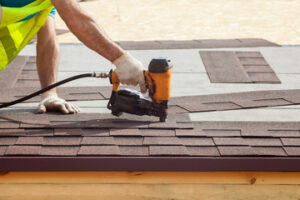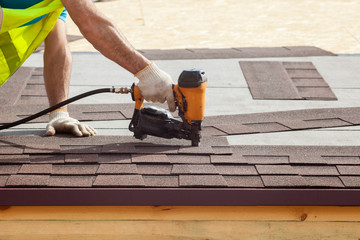 If the damage was caused by an unexpected event, you can pay for a roof replacement with your homeowner’s insurance. You can also take out a personal loan to cover the cost of the work.
If the damage was caused by an unexpected event, you can pay for a roof replacement with your homeowner’s insurance. You can also take out a personal loan to cover the cost of the work.
It’s not a good idea to put new shingles over existing ones. This will create bumps, waves and other irregularities that can look bad. Visit the Roofing Replacement Collegeville PA to know more.
Aesthetics
Roofing is not always the most glamorous home improvement project, but it plays an important role in the overall aesthetics of a house. A roof’s style, color, and texture contribute to its curb appeal, complementing or enhancing the architectural style of the structure. It also provides protection from weather conditions and other environmental factors that can damage a building.
During the course of a re-roofing project, homeowners may decide to install new sections of shingles for aesthetic reasons. This can lead to a lumpy or uneven appearance. It can also be difficult for the second layer of shingles to lay flat over the more contoured look of the first. It is best to run the new shingles to a ridge or valley to hide the comparison of old and new.
Aesthetics tend to be a secondary concern for many homeowners when replacing their roof, but it should not be neglected. A beautiful roof not only protects a building from the elements, but it can also boost its curb appeal and add to the value of a property.
Durability
Roofing replacement offers a long lifespan for your home. If you are looking for a durable option, consider premium asphalt shingles. They typically last 30 years and come with a warranty. Clay tiles are another durable choice, as they can last for 50 years or more. Other roofing options include built-up, which is rolled on in layers, and modified bitumen, which is similar to built-up but lighter and offers a lifetime warranty. When choosing a new roof, be sure to prune trees back from the house and move outdoor objects that could get hit by debris during re-roofing.
Energy efficiency
Re-roofing is a common way to improve the functionality and aesthetics of a home’s roof without having to replace it entirely. Re-roofing adds a layer of protection over the existing shingles and can extend the lifespan of the roofing materials. Additionally, re-roofing can help reduce energy costs by increasing the insulation value of the roof. However, re-roofing can also add to the cost of a home remodel. This is because most building codes only allow two layers of roofing, and removing the existing roof can cost more than replacing it with new materials.
Before beginning a re-roofing project, homeowners should cut back any trees that are encroaching on the roof and move any outdoor objects. This will prevent the items from falling onto the roof during construction and potentially breaking. It is also a good idea to clear the attic of any objects that could fall through gaps in the ceiling. This will prevent expensive pictures from being damaged by vibrations and debris during re-roofing.
During a re-roofing job, the experts will usually inspect and bring the attic’s insulation up to code. This is one of the most important factors that translates into energy savings. Poor insulation allows heat to escape the house during the summer and can lead to astronomical air conditioning bills. In addition, some states offer tax rebates to homeowners who increase the insulation value of their homes. In addition to adding new insulation, the professionals will also install intake vents and exhaust vents. These will promote a natural process in which cool air enters the attic and rises to the ridge, where it exits through the exhaust vents. This helps to keep the house cooler in the summer and prevents mold and rot.
Cost
When the roof on a home is damaged, it may be time to consider re-roofing. A new roof will protect the house from moisture damage and improve its energy efficiency, and it can also add value to the property. However, there are many factors that can affect the cost of a roofing replacement. Some are outside the homeowner’s control, while others can be controlled by their choice of roofing materials. These factors include the type of roofing material chosen, the roof’s pitch (the steepness of the slope), and the roofing contractor.
The first factor that impacts the cost of a new roof is the type of shingles used. Basic, three-tab asphalt shingles are the least expensive and last for about 20 years. However, they can be subject to wind damage and are not designed to withstand winds above 90 MPH. For this reason, some local municipalities require homeowners to re-roof their homes with a stronger roof material.
Another factor that impacts the cost of a new roofing system is the size of the building. A larger roof requires more shingles and more labor to install them. In addition, a larger roof may require more ventilation and may be subject to more leaks. In this case, a roofing contractor will need to install extra vents and ridge caps, which increase the overall cost of the roof.
A third factor that can impact the cost of a new roof is the location of the home. Some areas experience harsh weather conditions that require roofing materials that can withstand high temperatures and extreme rains. For this reason, homeowners in these regions will typically pay more for a roof than those in less-extreme locations.
Homeowners can reduce the costs of a roof by choosing cheaper materials, such as slate, tile, or wood shakes. These materials can add value to the home, and they often have a more distinctive appearance than traditional asphalt shingles. However, they can be more expensive to install, and they may need modification to the building frame to support the weight of these materials.
In addition to their durability, asphalt shingles are also known for their low maintenance and long lifespan. However, the longevity of your asphalt shingle roof will be dependent on your region’s weather and its ability to resist extreme temperatures, winds, fire and ice.
Metal roofing panels are available in a wide variety of styles and colors that complement many architectural aesthetics. They are a popular choice for homes in coastal environments and are durable enough to withstand the heavy winds associated with hurricanes and typhoons. Additionally, they are often more affordable than other roofing materials and can increase the resale value of your home.
The lightweight design of metal roofs makes them easier to handle during installation. This reduces labor costs and overall project completion time. Unlike other roofing types, metal roofs are non-combustible, which is an important safety feature for properties located in fire-prone areas.
Although metal roofs offer a number of benefits, they have some drawbacks that homeowners should be aware of. Some of these include expansion and contraction, exposed fasteners and varying lifespans of the neoprene washers and screws used in their construction. These fasteners are designed to withstand the elements, but they may degrade over time. They can also be difficult to replace if they become dislodged.
Another issue with metal is the potential for thermal expansion and contraction. When hot weather hits, the metal expands and this can put stress on seams, panels, and other components of a roof system. Conversely, when the weather cools down and the metal shrinks, gaps can develop and create stress on the roof structure.
When exposed to the elements, aluminum has a shorter life expectancy than other metal roofing materials. While it is durable and easy to install, aluminum does not have as many color options and tends to be less attractive in appearance than other metal roofs.
A metal roof can reflect up to 50 percent of the sun’s heat, which lowers your energy bills during peak summer temperatures. However, it is important to keep in mind that dark-colored metal roofs tend to absorb more heat than lighter-colored varieties. As a result, darker metal roofs are typically more expensive than their lighter-colored counterparts. A new heat-reflective coating can improve the durability of your roof and help to offset these additional costs.
